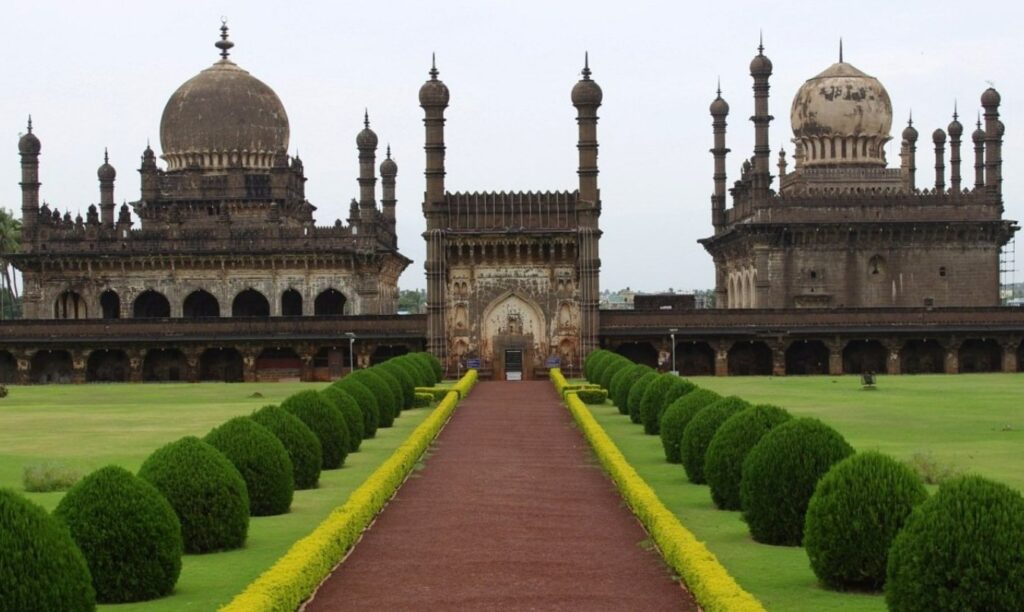Discover Vijayapura, Karnataka’s heritage city, known for its grand monuments, historic forts, stunning domes, and rich cultural legacy. A treasure trove of history!

Explore Vijayapura: Karnataka’s Land of Architectural Marvels
Vijayapura District, located in the northwestern part of Karnataka, India, is a region steeped in history and cultural richness. With a history dating back to ancient times, the district is a treasure trove of heritage, architecture, and diverse traditions. Spread over an area of approximately 10,500 square kilometers, Vijayapura District is home to a population that engages in a variety of occupations, including agriculture, trade, and handicrafts.
The district’s name itself, which means “City of Victory,” resonates with its historical significance. One of the most prominent landmarks is the Bijapur Fort, a UNESCO World Heritage Site. This architectural marvel showcases the blend of Islamic and Hindu architectural styles, exemplified by structures like the Gol Gumbaz, a massive dome with the world’s second-largest unsupported dome. The fort also houses mosques, palaces, and other structures that stand as testaments to the region’s diverse history.
Vijayapura District has been a melting pot of cultures, languages, and traditions. Kannada, the official language, is widely spoken, but Urdu, Marathi, and Telugu are also used due to the district’s historical interactions with neighboring states. The district is known for its traditional crafts, including the renowned Bijapur sarees that are characterized by intricate weaving and vibrant colors. Artisans also create exquisite jewelry, woodwork, and Bidriware, a metalwork technique known for its intricate silver inlays on blackened alloy.
Agriculture forms the backbone of the district’s economy, with crops like jowar, cotton, and sunflower being major contributors. The Krishna River, which flows through the district, has played a crucial role in irrigation, enhancing agricultural productivity. Additionally, horticulture and floriculture have gained prominence, contributing to the district’s economic growth.
The region celebrates a rich tapestry of festivals that showcase its cultural diversity. The annual Bijapur Music Festival draws music enthusiasts from across the country, highlighting the district’s support for the arts. Traditional festivals like Eid-ul-Fitr, Diwali, and Ugadi are celebrated with great fervor, fostering communal harmony.
Despite its historical significance, Vijayapura District faces certain challenges that need attention. Infrastructure development, healthcare access, and education are areas that require continuous improvement. Efforts to preserve the historical monuments and cultural heritage must be balanced with modern development initiatives.
In recent years, there has been a push towards promoting tourism in the district, capitalizing on its historical heritage and cultural diversity. The local administration has been working to improve connectivity, accommodation, and visitor facilities to attract tourists interested in exploring the region’s architectural wonders and experiencing its vibrant traditions.
Vijayapura District, with its rich history, cultural fusion, and agricultural prominence, stands as a testament to the enduring spirit of its people. As it navigates the path of progress, it strives to maintain a harmonious balance between its illustrious past and the aspirations of its future generations.
Famous Places in Vijayapura District
Vijayapura District is renowned for its historical landmarks and architectural wonders that offer a glimpse into its rich heritage. Some of the famous places in the district include:
Bijapur Fort: This UNESCO World Heritage Site is a symbol of Vijayapura’s historical significance. The fort complex houses notable structures like Gol Gumbaz, Ibrahim Rouza, and Jami Masjid, showcasing a blend of Islamic and Indian architectural styles.
Gol Gumbaz: Known for its colossal dome, Gol Gumbaz is the second-largest dome in the world, attracting visitors with its architectural marvel and impressive whispering gallery.
Ibrahim Rouza: A mausoleum complex that features stunning Persian-style architecture, known for its symmetry, intricate carvings, and tranquil surroundings.
Jami Masjid: This grand mosque is an architectural masterpiece, known for its spacious courtyard, elegant arches, and detailed calligraphy.
Malik-e-Maidan: A historic cannon placed on a tower, considered one of the largest medieval cannons in the world, reflecting the engineering prowess of its time.
Asar Mahal: A beautiful palace that served as a religious and educational center during the Adil Shahi dynasty, known for its exquisite Persian and Indo-Saracenic architecture.
Chand Bawdi: An ancient stepwell that showcases the architectural ingenuity of the past, offering a unique glimpse into the region’s water management techniques.
Anand Mahal: A palace known for its stunning frescoes, intricate motifs, and artistic interiors, providing insights into the luxurious lifestyle of the rulers.
Bara Kaman: An incomplete mausoleum complex with twelve arches, showcasing the ambitious architectural vision of Ali Adil Shah II.
Gagan Mahal: Once a majestic palace, Gagan Mahal is now a historical site that offers a glimpse into the grandeur of the Adil Shahi era.
Saath Kabar (Seven Tombs): A collection of seven tombs built for the Adil Shahi rulers, featuring unique architectural elements and intricate designs.
Bijapur Archaeological Museum: Displaying a rich collection of sculptures, artifacts, and historical items, the museum provides deeper insights into the district’s history.
These famous places in Vijayapura District offer a captivating journey through time, inviting travelers and history enthusiasts to explore the district’s remarkable architectural heritage and cultural significance.
Read More :-
